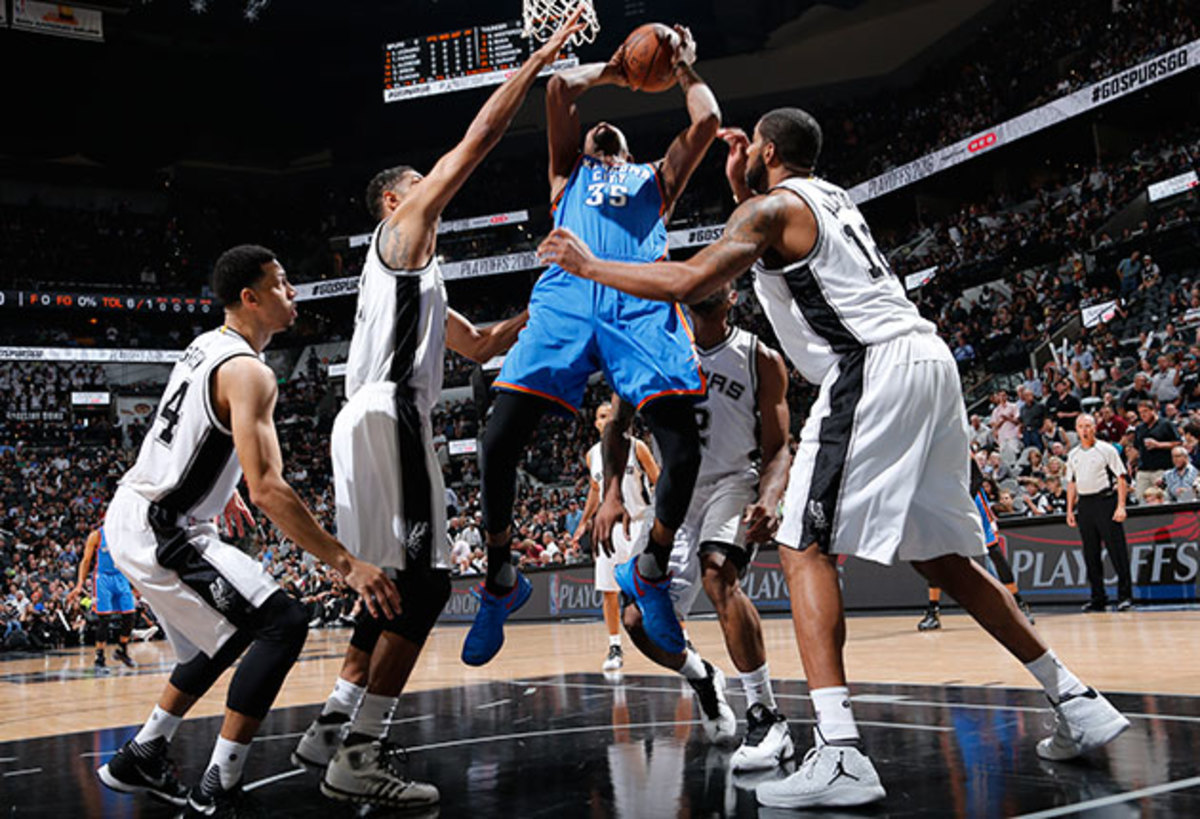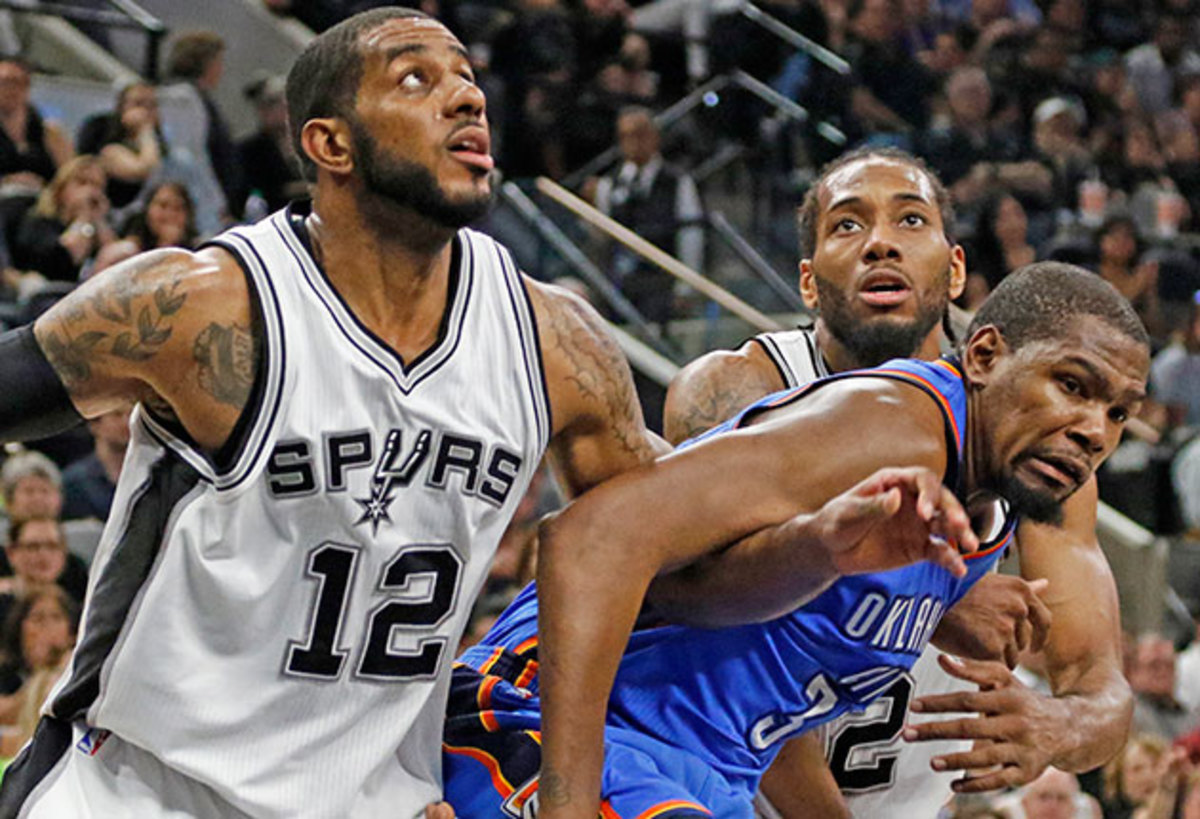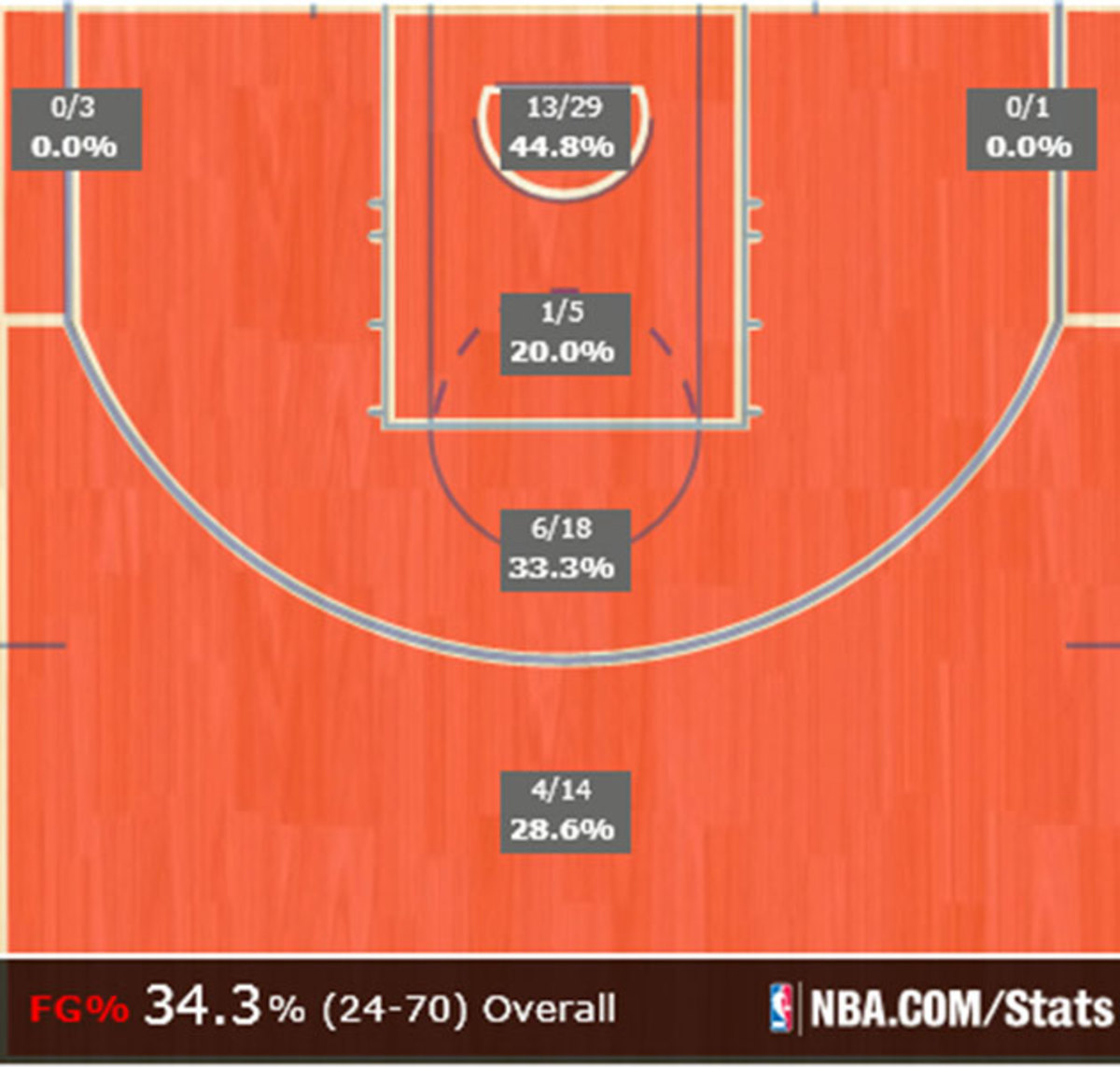Spurs facing disaster despite finding ways to contain Westbrook, Durant

Get all of Rob Mahoney's columns as soon as they’re published. Download the new Sports Illustrated app (iOS or Android) and personalize your experience by following your favorite teams and SI writers.
SAN ANTONIO — The San Antonio Spurs find themselves in a dangerous predicament. Thursday could well mark the end of their season, after a loss to the Oklahoma City Thunder in Game 5 officially broached the prospect of elimination. Buried in that possibility is a somewhat dispiriting feat: In its series to date, San Antonio has defended Russell Westbrook and Kevin Durant about as well as a team reasonably could…and still finds itself down, 2-3.
Let’s start with the concept. The Spurs’ defensive plans are built from a platform of choice—a luxury that most teams cannot afford. Often, matchups and base principles in the NBA are settled almost by default; the question of who guards an opposing superstar, for example, tends to be much simpler when only one defender on the roster is up for the task. San Antonio has enough options to toggle its approach and take on a more flexible feel. Elective strategy lends itself to adaptive strategy.
Rarely is that kind of choice made so explicit as in this series. Westbrook and Durant should each, independently, demand a defense’s full attention. To guard both at the same time thus locks most teams into a particular kind of coverage rooted in deficit management. The wing with the longest reach usually takes Durant, while the guard with the quickest feet takes Westbrook. San Antonio balks at the thought. Kawhi Leonard, an all-time defender in the mold of a traditional Durant foil, picked up Westbrook at the top of the key on the very first possession of the series. He’s matched up with the explosive point guard on and off in every game since, alternating in tandem with shooting guard Danny Green.
• MORE NBA: Thunder harness defensive energy to steal Game 5 victory

Or, as was the case in Game 5: The Spurs can punt on the premise. Rather than position Leonard to challenge either Westbrook or Durant, San Antonio’s coaching staff slotted the reigning Defensive Player of the Year to ignore Andre Roberson in the corner and operate as constant, roving help. Leonard as a defensive stopper is vicious, if specific. To have him instead loom on the edge of every possession makes his coverage downright ominous. No pass is safe and no driving lane is guaranteed.
[youtube=https://youtu.be/OtACKwzcUBo]
This alignment accomplished two primary objectives. First, it allowed the Spurs to maintain their pressure on Durant and Westbrook while leaving their screeners temporarily open. Oklahoma City exploited this wrinkle in Game 4 to set up Steven Adams for downhill rolls to the rim. Those opportunities were much harder to come by with Leonard in stifling help position at every turn. There is a considerable difference between having Leonard carry out that responsibility relative to Tony Parker, who played a similar roving role earlier in the series. Second, Spurs head coach Gregg Popovich spoke specifically to the value of using this kind of matchup as a relief amid Leonard’s game-long responsibilities.
“He guarded Westbrook,” Popovich said. “He guarded Durant. He guarded Roberson. We just didn’t want him to have to guard those guys all night long.”
The freedom to shuffle one of the best perimeter defenders in NBA history and a second, all-league-caliber defender in Green gives San Antonio a high-end viability. The two might swap assignments coming out of a timeout to throw the Thunder off balance. Leonard might move over to Durant in crunch time to protect against a post-up. Other exchanges are more periodic than triggered, and some occur naturally over the course of providing help within a single possession. The 1-3 pick-and-roll, for example, has been rooted out of OKC’s playbook in any instance when Leonard and Green guard the two Thunder stars directly. One of the single, most powerful actions in the league is solved with a switch.
• MORE NBA: 2016 NBA playoffs: Latest playoff schedule, analysis, results

Both Spurs defenders have internalized two detailed, specific, and very different scouting reports for execution in a high-stakes environment.
“It's tough,” Green admits. “But as a player, you've just gotta be professional and know who you're guarding, know the personnel—the guy's strengths and weaknesses. We've also been playing these guys for some years now and watching them for some years now also. So you know what they're good at, what their strengths are, and obviously even their weaknesses are pretty good. We have to kinda live with them trying to beat us with their weaknesses. When you get on that guy, you kinda just hone in on what you have to do to stop their strengths. If we switch, no matter who it is—you've got to lock in as a defender and as a professional and think: What do I have to make this guy do?”
With Durant, the defense has thus far has aimed to make him work to even receive the ball. Isolation possessions are challenged on the catch. Those that make it to Durant often require that he give up his preferred position to field an entry pass. Those that don’t are generally tapped away by Green, who has been selling out hard enough in post denial that Thunder coach Billy Donovan cited the need to work around Green’s defense after Game 5.
[youtube=https://youtu.be/HHiQgn6FJJ0]
Regardless, there will be a handful of possessions every game in which Durant renders the defense irrelevant. Green or Leonard could do everything right and suffer simply for having to guard one of the NBA’s finest. Only so much can be done to prevent Durant from taking a shot. Once resolved, even the act of challenging his high release point can be an arduous task. Both wings (along with a few guest defenders) try their damnedest, but Durant, by and large, has shot over the top of stout coverage to score well. San Antonio’s only assurances come in knowing that Durant has to invest in cuts and curls just to make every attempt possible, and that the coverage is at least partly responsible for his 21 turnovers through five games. Suppressing Durant’s production in any way requires a complete team effort.
“It's not about 1-on-1,” Durant said. “It's not about me vs. Danny Green or me vs. Kawhi Leonard. It's about who has the best team defense.”
In Westbrook’s case, playing to the scouting report involves getting ahead of a terrifying first step. The Thunder point guard blows by his on-ball defender as often as anyone in the league. His crossover is quick and brutal. The threat of his pull-up is enough to lull many opponents up and out of their stance. Give him any angle and Westbrook will be on his way to the rim. Give him nothing and he may streak past anyway.
Yet in the minutes that Leonard and Green are on the floor together, Westbrook’s shot chart becomes a graveyard of encouraged jumpers and contested layups:

When defended by either wing, Westbrook has to exert a lot of effort just to create the space necessary to pull up:
[youtube=https://youtu.be/p0UzmF9ZB7U]
Leonard is particularly effective in rushing Westbrook, who plays warily of the much longer forward’s pursuit. It helps, too, that the defensive structure against Westbrook and Durant includes a built-in safety net. All series long, the Spurs have attempted to station as many bodies as possible between the Thunder superstars and the rim. Even if Westbrook does manage to get the jump on Leonard, he must then navigate the assortment of defenders dotted around the paint:
[youtube=https://youtu.be/3_TJmHGnqpU]
“They're too good to feel like they're just out there playing against their guy,” Spurs forward David West said. “They just have to see a wall. They have to know that all eyes are on them. It's not just one guy guarding any of their guys. It's all five of us on the floor guarding the ball. They're so dangerous, athletic, explosive. You've gotta be almost perfect defensively to keep them below their averages and keep them under control.”
As demonstrated in Game 5, the Spurs inch closer to that kind of perfect coverage when Tim Duncan is able to take his place on the wall. Oklahoma City had done a tremendous job of attacking Duncan by leaving him be; much in the same way San Antonio exploited Roberson’s lack of shooting range, OKC’s defenders didn’t bother treating the reluctant Duncan as any kind of scoring threat. His rolls down the lane were eventually contested but not made a point of concern. His catches on the perimeter were flatly ignored and his post-ups easily contained. The most effective way to neutralize a defender is to create the cause to remove him from the floor entirely. For most of Games 3 and 4, the Thunder succeeded in doing just that—guarding Duncan in a way that curbed his minutes and impact.
• MORE NBA: Ranking every head coaching job in the NBA
Pop veered back with his rotation in Game 5, undoubtedly disturbed by the way San Antonio’s non-Duncan lineups were routed on the glass in the game prior. Duncan—even while shooting 1-of-6 from the field—responded with his best game of the series.
[youtube=https://youtu.be/AjeuR-3qBd4]
“One wouldn’t expect a 40-year-old to do what he did when he was 24,” Popovich said. “What [Duncan] still gives us is a base from which to operate. He’s a tremendous leader. He has a great passion for the game. He’s one of the best teammates you can imagine. He’s smart enough to try and do fundamental things—like rebound, block shots, change shots—whenever he can. Be in the right place on the court, help teammates understand what’s going on.”
The Spurs need Duncan on the floor for as many minutes as the offense can handle. But given San Antonio’s unexpected scoring difficulty in recent games, that balance is quite precarious. Lineups featuring all three of Leonard, Green, and Duncan have held the Thunder to a mere 95.6 points per 100 possessions since Game 1, according to NBA.com. Unfortunately for the Spurs, those same groups have been able to score just 94.5 points of their own—wasting exquisite defense on a negative differential.
Therein lies the rub of Game 5—not only in Duncan’s minutes, but throughout San Antonio’s entire rotation. The defense was good enough to hold. Oklahoma City had turned the ball over on more than a fifth of their possessions. Durant made but a third of his 21 shots. Strong contests through multiple offensive rebounds limited the Thunder’s second-chance points. Responsibility on critical plays had fallen to the likes of Enes Kanter and Dion Waiters. And for as good as Westbrook was, his crazy point total only came to pass through some poor shot selection.
San Antonio has done everything necessary to take a 3-2 series lead, except for putting up the points to make it a reality. At this level of competition, defense alone is a half-measure.
